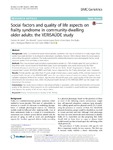Mostrar o rexistro simple do ítem
Social factors and quality of life aspects on frailty syndrome in community-dwelling older adults: the VERISAÚDE study
| dc.contributor.author | Labra, Carmen de | |
| dc.contributor.author | Maseda, Ana | |
| dc.contributor.author | Lorenzo-López, Laura | |
| dc.contributor.author | López-López, Rocío | |
| dc.contributor.author | Buján, Ana | |
| dc.contributor.author | Rodríguez-Villamil, José Luis | |
| dc.contributor.author | Millán-Calenti, José Carlos | |
| dc.date.accessioned | 2018-03-15T12:10:38Z | |
| dc.date.available | 2018-03-15T12:10:38Z | |
| dc.date.issued | 2018-03-07 | |
| dc.identifier.citation | de Labra C, Maseda A, Lorenzo-López L, López-López R, Buján A, Rodríguez-Villamil JL, Millán-Calenti JC. Social factors and quality of life aspects on frailty syndrome in community-dwelling older adults: the VERISAÚDE study. BMC Geriatr. 2018 Mar 7;18(1):66. | es_ES |
| dc.identifier.issn | 1471-2318 | |
| dc.identifier.uri | http://hdl.handle.net/2183/20318 | |
| dc.description.abstract | [Abstract] Background. Frailty is a multidimensional clinical geriatric syndrome that may be reversed in its early stages. Most studies have paid attention to its physical or phenotypic boundaries, however, little is known about the social aspects surrounding this geriatric syndrome. The study examined the relationship between socio-demographic factors, social resources, quality of life and frailty in older adults. Methods. This cross-sectional study included a representative sample (n = 749) of adults aged ≥65 years enrolled in forty-three senior centers located in North-West Spain. Socio-demographic data, social resources by the Older Americans Resources and Services Scale, quality of life by the World Health Organization’s Quality of Life measure-brief version (WHOQOL-BREF), and frailty status diagnosed by the Frailty phenotype were measured. Results. Female gender, age older than 75 years, single marital status, a poor quality of life, and low scores in the physical health domain of the WHOQOL-BREF were the main determinants of being non-robust. Together, these variables explained 24.4% of the variance. Age between 80 and 89 years, and a poor quality of life were the main determinants for non-robust men, whilst the physical health domain of the WHOQOL-BREF was the single main determinant for women. Conclusions. Our study found evidence that physical frailty is associated with social determinants and several quality of life domains. More research on this understudied topic is needed to avoid healthcare expenditures and improve the quality of life of non-robust elders. | es_ES |
| dc.description.sponsorship | Xunta de Galicia; IN607C 2016/08 | es_ES |
| dc.description.sponsorship | Xunta de Galicia; ED431C 2017/49 | es_ES |
| dc.description.sponsorship | Xunta de Galicia; EM 2012/100 | es_ES |
| dc.language.iso | eng | es_ES |
| dc.publisher | BioMed Central | es_ES |
| dc.relation.uri | http://dx.doi.org/10.1186/s12877-018-0757-8 | es_ES |
| dc.rights | Creative Commons Attribution 4.0 International License (CC-BY 4.0) | es_ES |
| dc.rights.uri | http://creativecommons.org/licenses/by/4.0/ | * |
| dc.subject | Frailty | es_ES |
| dc.subject | Social resources | es_ES |
| dc.subject | Quality of life | es_ES |
| dc.subject | Elderly | es_ES |
| dc.title | Social factors and quality of life aspects on frailty syndrome in community-dwelling older adults: the VERISAÚDE study | es_ES |
| dc.type | info:eu-repo/semantics/article | es_ES |
| dc.rights.access | info:eu-repo/semantics/openAccess | es_ES |
| UDC.journalTitle | BMC Geriatrics | es_ES |
| UDC.volume | 18 | es_ES |
| UDC.startPage | 66 | es_ES |
Ficheiros no ítem
Este ítem aparece na(s) seguinte(s) colección(s)
-
GI-GIGG - Artigos [113]
-
INIBIC-IX - Artigos [31]






